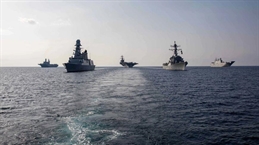
The agreement between Israel and Hamas to pause their conflict has raised hopes over the prospect of containerships returning to the Red Sea, but a period of uncertainty and volatility in ocean supply chains persists and a new Xeneta analysis said it will take time for ocean carriers to resume operations on this route.
Peter Sand, chief analyst at Xeneta, said an agreement to pause fighting does not necessarily mean a large-scale return of container ships to the Red Sea and while a ceasefire is a "significant step forward," there is still a long way to go before a real peace deal is reached.
"Carriers will want assurance they have safe passage for crews and ships in the long term and that the situation will not suddenly deteriorate," he wrote.
Sand noted that diversions around the Cape of Good Hope are not what the industry wants, but the situation is stable and is currently being managed.
"It took many months and extreme disruption to achieve this stability so carriers will be wary of heading back to the Red Sea too soon. If it goes wrong, they're back to square one. Therefore, an immediate large-scale return is highly unlikely," the Xeneta chief analyst added.
Sand said the ceasefire may also mean that carriers will start by sending ships with a capacity below 10,000 TEU (20ft equivalent container) through the Red Sea. Once this is done, they will gradually increase the size of vessels transiting the region before finally the very large 18,000-24,000 TEU containerships.
"The complexity of ocean container shipping networks means it could take 1-2 months for schedules to transition to ‘normal’ operating conditions through the Red Sea," he added.
Severe disruptions once Red Sea sailing begins
The Xeneta analysis expects that there will be "severe disruption" in the immediate period following the return of ships to the Red Sea.
"When you consider sailing times on a trade that would ordinarily transit the Suez Canal, such as Shanghai to New York, is 30-40 days, you begin to see why it will take time for schedules to adjust," Sand said, adding that ships will not be where they are supposed to be and will arrive at ports much earlier (or later) than scheduled.
"If large numbers of ships arrive at ports at the same time, it will cause massive delays and congestion that ripple across ocean supply chains," he added.
Sand pointed out that when the conflict in the Red Sea escalated in December 2023, there was disruption in the immediate aftermath, but it was more than six months later when the real force of congestion hit and sent spot rates spiralling.
"There will be chaos as schedules adjust to routes through the Suez Canal. Spot rates will be extremely volatile but trending strongly downwards," he said, adding that much will depend on carriers' capacity management.
The Xeneta chief analyst also said that a large-scale return to the Red Sea would mean the global average sailing distances would drop to pre-crisis levels.
Sand noted that even with a forecasted 3% growth in global volumes in 2025, TEU-mile demand could be down 11% from 2024 if there is a large return to the Red Sea.
"Combined with record deliveries of new ships, the market will be flooded with capacity, with carriers needing to remove around 1.8 million TEU to retain the status quo," he said.
"Scrapping of ships will increase and carriers have gotten much better at capacity management in recent years, but it is unlikely this will be enough to prevent freight rates from collapsing," Sand added.
Israel-Hamas ceasefire
While the details of the ceasefire agreement between Israel and Hamas, which triggered Houthi attacks on shipping in the Southern Red Sea and the Gulf of Aden, remain largely undisclosed, reports indicate it will unfold in three phases.
The first phase is anticipated to involve a complete ceasefire lasting six weeks, the release of numerous hostages, and the withdrawal of Israeli troops from heavily populated areas in Gaza.
The second phase is expected to include the release of any remaining Israeli hostages, alongside the release of Palestinian prisoners held by Israel and a comprehensive withdrawal of Israeli forces from Gaza. The final phase is believed to focus on the reconstruction of Gaza.



